A Research Proposal on Managing Cultural Diversity at the Workplace
VerifiedAdded on 2023/01/13
|14
|4176
|68
Project
AI Summary
This document presents a research proposal focusing on managing cultural diversity in the workplace, particularly within the context of M&S. The proposal outlines the research topic, aims, objectives, and research questions related to the importance of diversity, strategies for managing it, and its impact on employee behavior and performance. It includes a literature review, highlighting key concepts, challenges, and strategies for promoting diversity, such as inclusion activities, employee education, and effective communication. The proposal also details the research approach and methodologies, including the use of positivism philosophy and qualitative research methods. The document concludes with a discussion of activities, timescales, and a Gantt chart for the research project. Desklib provides a platform for students to access this and other solved assignments.
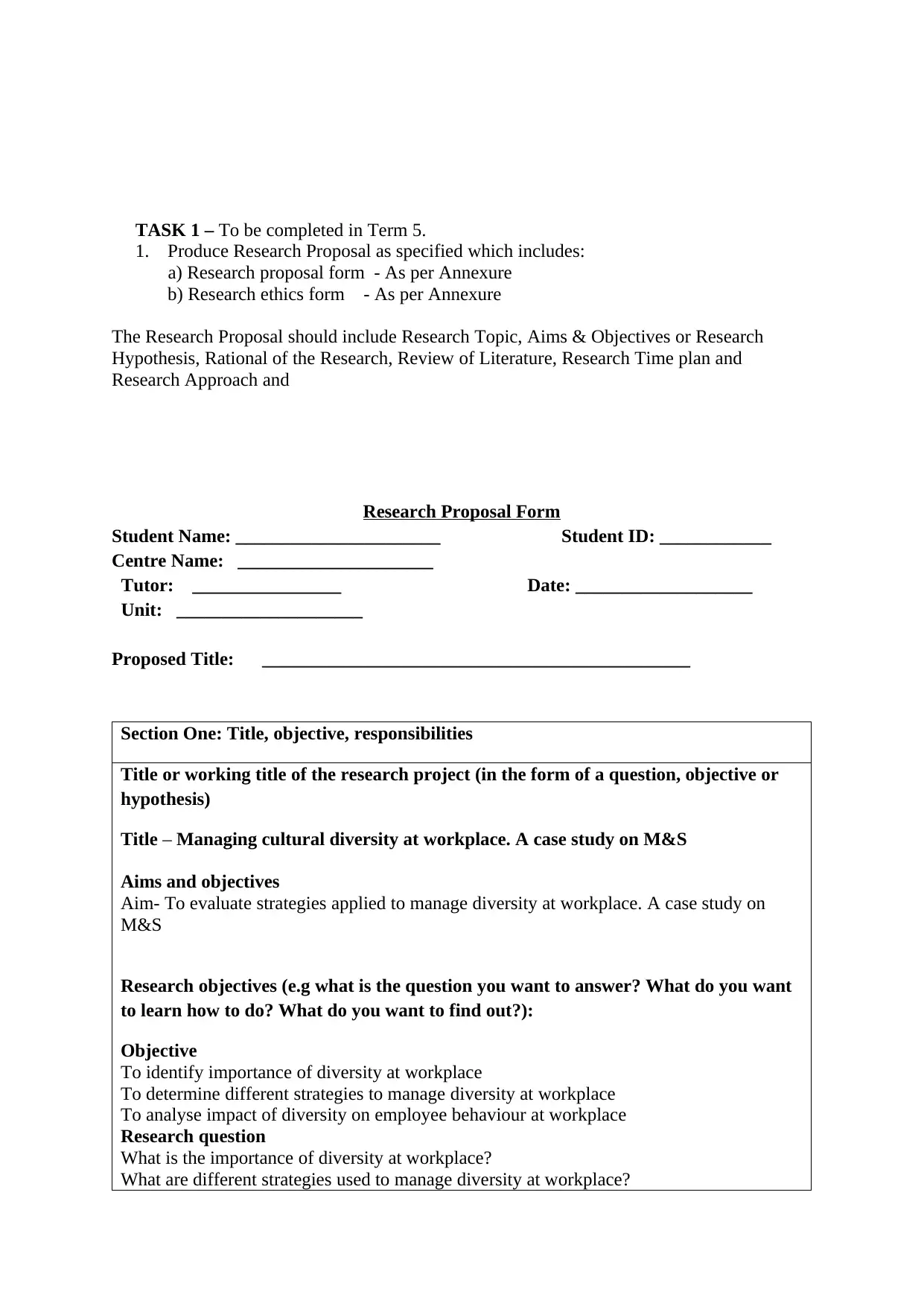
TASK 1 – To be completed in Term 5.
1. Produce Research Proposal as specified which includes:
a) Research proposal form - As per Annexure
b) Research ethics form - As per Annexure
The Research Proposal should include Research Topic, Aims & Objectives or Research
Hypothesis, Rational of the Research, Review of Literature, Research Time plan and
Research Approach and
Research Proposal Form
Student Name: ______________________ Student ID: ____________
Centre Name: _____________________
Tutor: ________________ Date: ___________________
Unit: ____________________
Proposed Title: ______________________________________________
Section One: Title, objective, responsibilities
Title or working title of the research project (in the form of a question, objective or
hypothesis)
Title – Managing cultural diversity at workplace. A case study on M&S
Aims and objectives
Aim- To evaluate strategies applied to manage diversity at workplace. A case study on
M&S
Research objectives (e.g what is the question you want to answer? What do you want
to learn how to do? What do you want to find out?):
Objective
To identify importance of diversity at workplace
To determine different strategies to manage diversity at workplace
To analyse impact of diversity on employee behaviour at workplace
Research question
What is the importance of diversity at workplace?
What are different strategies used to manage diversity at workplace?
1. Produce Research Proposal as specified which includes:
a) Research proposal form - As per Annexure
b) Research ethics form - As per Annexure
The Research Proposal should include Research Topic, Aims & Objectives or Research
Hypothesis, Rational of the Research, Review of Literature, Research Time plan and
Research Approach and
Research Proposal Form
Student Name: ______________________ Student ID: ____________
Centre Name: _____________________
Tutor: ________________ Date: ___________________
Unit: ____________________
Proposed Title: ______________________________________________
Section One: Title, objective, responsibilities
Title or working title of the research project (in the form of a question, objective or
hypothesis)
Title – Managing cultural diversity at workplace. A case study on M&S
Aims and objectives
Aim- To evaluate strategies applied to manage diversity at workplace. A case study on
M&S
Research objectives (e.g what is the question you want to answer? What do you want
to learn how to do? What do you want to find out?):
Objective
To identify importance of diversity at workplace
To determine different strategies to manage diversity at workplace
To analyse impact of diversity on employee behaviour at workplace
Research question
What is the importance of diversity at workplace?
What are different strategies used to manage diversity at workplace?
Paraphrase This Document
Need a fresh take? Get an instant paraphrase of this document with our AI Paraphraser
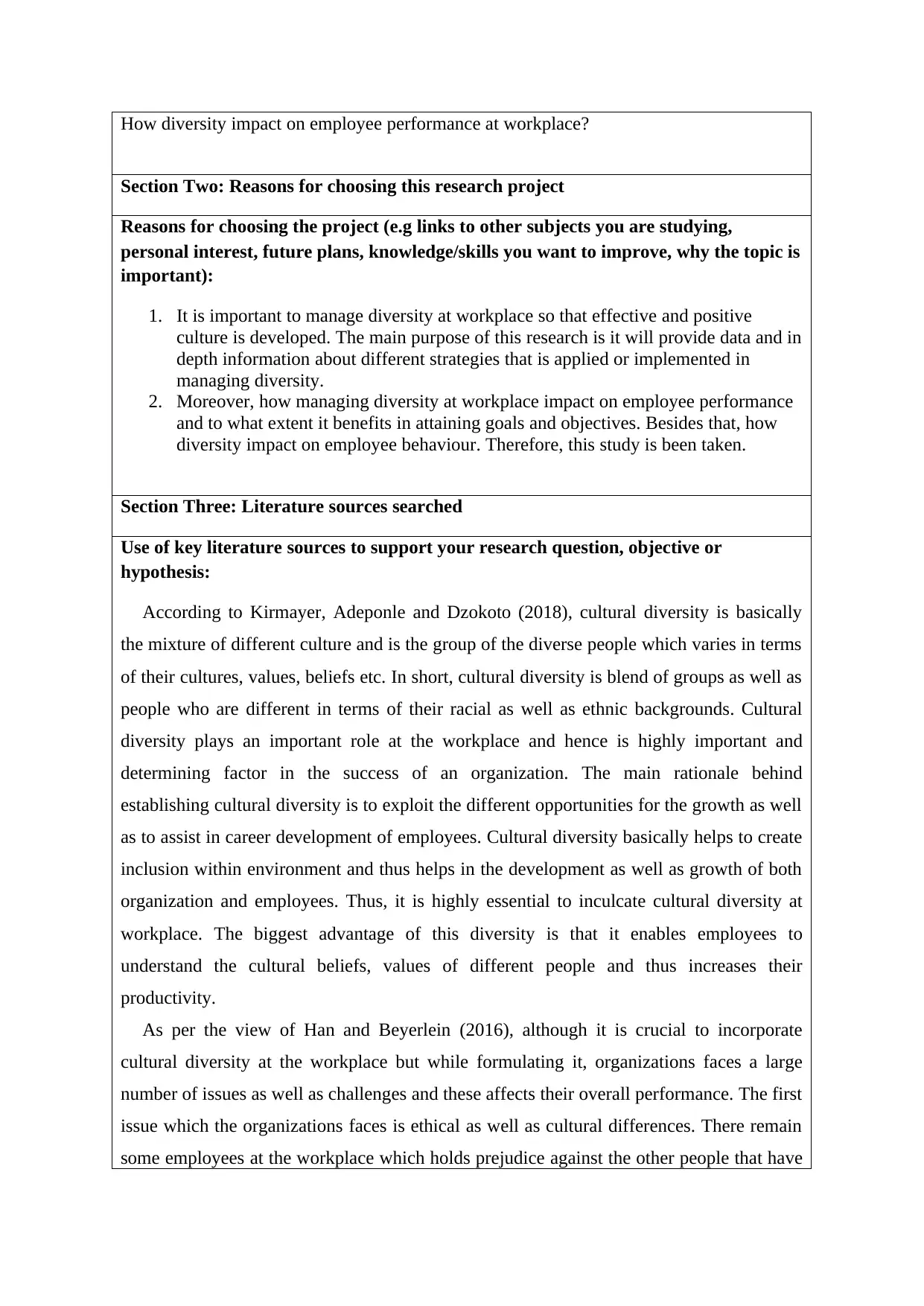
How diversity impact on employee performance at workplace?
Section Two: Reasons for choosing this research project
Reasons for choosing the project (e.g links to other subjects you are studying,
personal interest, future plans, knowledge/skills you want to improve, why the topic is
important):
1. It is important to manage diversity at workplace so that effective and positive
culture is developed. The main purpose of this research is it will provide data and in
depth information about different strategies that is applied or implemented in
managing diversity.
2. Moreover, how managing diversity at workplace impact on employee performance
and to what extent it benefits in attaining goals and objectives. Besides that, how
diversity impact on employee behaviour. Therefore, this study is been taken.
Section Three: Literature sources searched
Use of key literature sources to support your research question, objective or
hypothesis:
According to Kirmayer, Adeponle and Dzokoto (2018), cultural diversity is basically
the mixture of different culture and is the group of the diverse people which varies in terms
of their cultures, values, beliefs etc. In short, cultural diversity is blend of groups as well as
people who are different in terms of their racial as well as ethnic backgrounds. Cultural
diversity plays an important role at the workplace and hence is highly important and
determining factor in the success of an organization. The main rationale behind
establishing cultural diversity is to exploit the different opportunities for the growth as well
as to assist in career development of employees. Cultural diversity basically helps to create
inclusion within environment and thus helps in the development as well as growth of both
organization and employees. Thus, it is highly essential to inculcate cultural diversity at
workplace. The biggest advantage of this diversity is that it enables employees to
understand the cultural beliefs, values of different people and thus increases their
productivity.
As per the view of Han and Beyerlein (2016), although it is crucial to incorporate
cultural diversity at the workplace but while formulating it, organizations faces a large
number of issues as well as challenges and these affects their overall performance. The first
issue which the organizations faces is ethical as well as cultural differences. There remain
some employees at the workplace which holds prejudice against the other people that have
Section Two: Reasons for choosing this research project
Reasons for choosing the project (e.g links to other subjects you are studying,
personal interest, future plans, knowledge/skills you want to improve, why the topic is
important):
1. It is important to manage diversity at workplace so that effective and positive
culture is developed. The main purpose of this research is it will provide data and in
depth information about different strategies that is applied or implemented in
managing diversity.
2. Moreover, how managing diversity at workplace impact on employee performance
and to what extent it benefits in attaining goals and objectives. Besides that, how
diversity impact on employee behaviour. Therefore, this study is been taken.
Section Three: Literature sources searched
Use of key literature sources to support your research question, objective or
hypothesis:
According to Kirmayer, Adeponle and Dzokoto (2018), cultural diversity is basically
the mixture of different culture and is the group of the diverse people which varies in terms
of their cultures, values, beliefs etc. In short, cultural diversity is blend of groups as well as
people who are different in terms of their racial as well as ethnic backgrounds. Cultural
diversity plays an important role at the workplace and hence is highly important and
determining factor in the success of an organization. The main rationale behind
establishing cultural diversity is to exploit the different opportunities for the growth as well
as to assist in career development of employees. Cultural diversity basically helps to create
inclusion within environment and thus helps in the development as well as growth of both
organization and employees. Thus, it is highly essential to inculcate cultural diversity at
workplace. The biggest advantage of this diversity is that it enables employees to
understand the cultural beliefs, values of different people and thus increases their
productivity.
As per the view of Han and Beyerlein (2016), although it is crucial to incorporate
cultural diversity at the workplace but while formulating it, organizations faces a large
number of issues as well as challenges and these affects their overall performance. The first
issue which the organizations faces is ethical as well as cultural differences. There remain
some employees at the workplace which holds prejudice against the other people that have
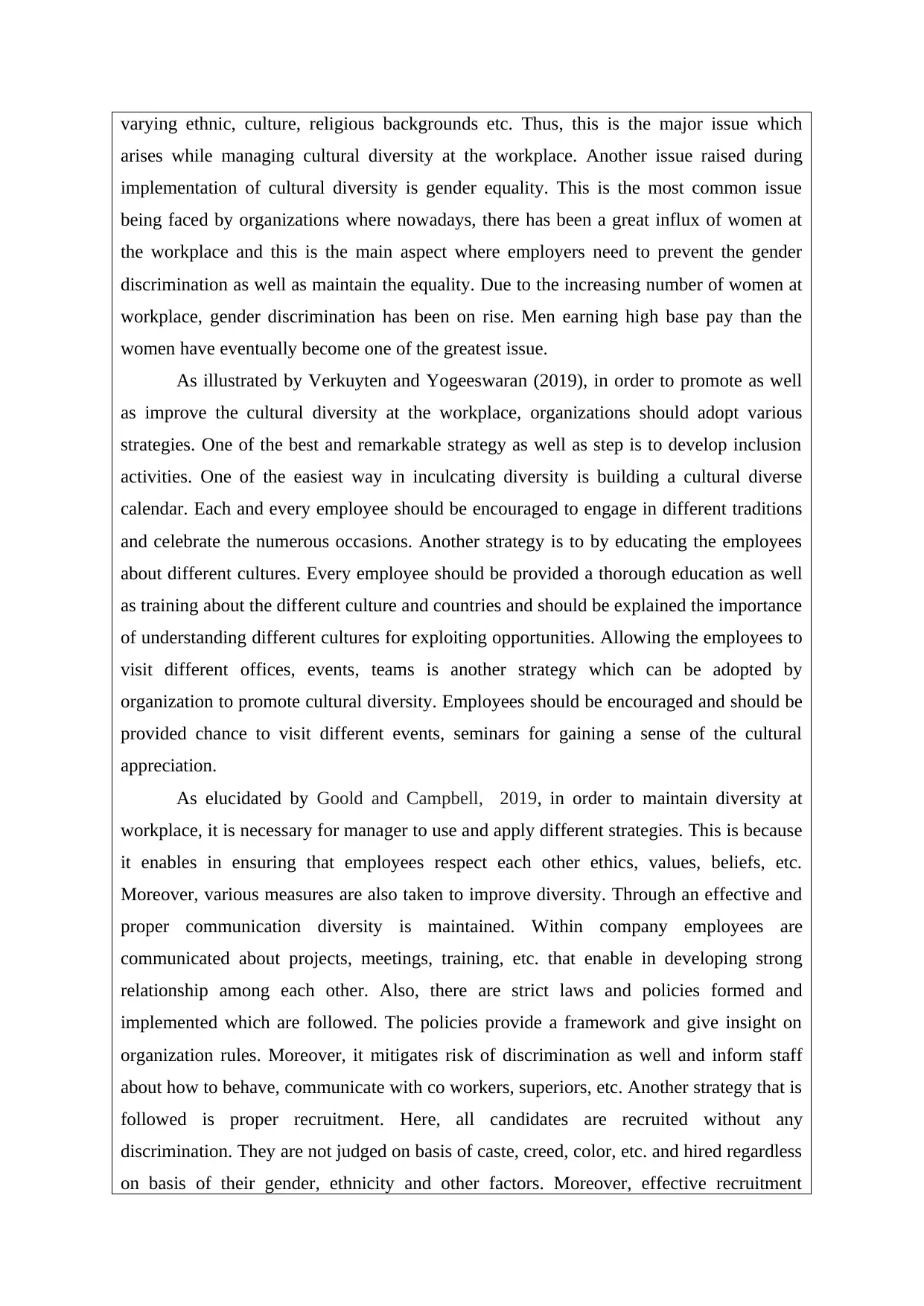
varying ethnic, culture, religious backgrounds etc. Thus, this is the major issue which
arises while managing cultural diversity at the workplace. Another issue raised during
implementation of cultural diversity is gender equality. This is the most common issue
being faced by organizations where nowadays, there has been a great influx of women at
the workplace and this is the main aspect where employers need to prevent the gender
discrimination as well as maintain the equality. Due to the increasing number of women at
workplace, gender discrimination has been on rise. Men earning high base pay than the
women have eventually become one of the greatest issue.
As illustrated by Verkuyten and Yogeeswaran (2019), in order to promote as well
as improve the cultural diversity at the workplace, organizations should adopt various
strategies. One of the best and remarkable strategy as well as step is to develop inclusion
activities. One of the easiest way in inculcating diversity is building a cultural diverse
calendar. Each and every employee should be encouraged to engage in different traditions
and celebrate the numerous occasions. Another strategy is to by educating the employees
about different cultures. Every employee should be provided a thorough education as well
as training about the different culture and countries and should be explained the importance
of understanding different cultures for exploiting opportunities. Allowing the employees to
visit different offices, events, teams is another strategy which can be adopted by
organization to promote cultural diversity. Employees should be encouraged and should be
provided chance to visit different events, seminars for gaining a sense of the cultural
appreciation.
As elucidated by Goold and Campbell, 2019, in order to maintain diversity at
workplace, it is necessary for manager to use and apply different strategies. This is because
it enables in ensuring that employees respect each other ethics, values, beliefs, etc.
Moreover, various measures are also taken to improve diversity. Through an effective and
proper communication diversity is maintained. Within company employees are
communicated about projects, meetings, training, etc. that enable in developing strong
relationship among each other. Also, there are strict laws and policies formed and
implemented which are followed. The policies provide a framework and give insight on
organization rules. Moreover, it mitigates risk of discrimination as well and inform staff
about how to behave, communicate with co workers, superiors, etc. Another strategy that is
followed is proper recruitment. Here, all candidates are recruited without any
discrimination. They are not judged on basis of caste, creed, color, etc. and hired regardless
on basis of their gender, ethnicity and other factors. Moreover, effective recruitment
arises while managing cultural diversity at the workplace. Another issue raised during
implementation of cultural diversity is gender equality. This is the most common issue
being faced by organizations where nowadays, there has been a great influx of women at
the workplace and this is the main aspect where employers need to prevent the gender
discrimination as well as maintain the equality. Due to the increasing number of women at
workplace, gender discrimination has been on rise. Men earning high base pay than the
women have eventually become one of the greatest issue.
As illustrated by Verkuyten and Yogeeswaran (2019), in order to promote as well
as improve the cultural diversity at the workplace, organizations should adopt various
strategies. One of the best and remarkable strategy as well as step is to develop inclusion
activities. One of the easiest way in inculcating diversity is building a cultural diverse
calendar. Each and every employee should be encouraged to engage in different traditions
and celebrate the numerous occasions. Another strategy is to by educating the employees
about different cultures. Every employee should be provided a thorough education as well
as training about the different culture and countries and should be explained the importance
of understanding different cultures for exploiting opportunities. Allowing the employees to
visit different offices, events, teams is another strategy which can be adopted by
organization to promote cultural diversity. Employees should be encouraged and should be
provided chance to visit different events, seminars for gaining a sense of the cultural
appreciation.
As elucidated by Goold and Campbell, 2019, in order to maintain diversity at
workplace, it is necessary for manager to use and apply different strategies. This is because
it enables in ensuring that employees respect each other ethics, values, beliefs, etc.
Moreover, various measures are also taken to improve diversity. Through an effective and
proper communication diversity is maintained. Within company employees are
communicated about projects, meetings, training, etc. that enable in developing strong
relationship among each other. Also, there are strict laws and policies formed and
implemented which are followed. The policies provide a framework and give insight on
organization rules. Moreover, it mitigates risk of discrimination as well and inform staff
about how to behave, communicate with co workers, superiors, etc. Another strategy that is
followed is proper recruitment. Here, all candidates are recruited without any
discrimination. They are not judged on basis of caste, creed, color, etc. and hired regardless
on basis of their gender, ethnicity and other factors. Moreover, effective recruitment
⊘ This is a preview!⊘
Do you want full access?
Subscribe today to unlock all pages.

Trusted by 1+ million students worldwide
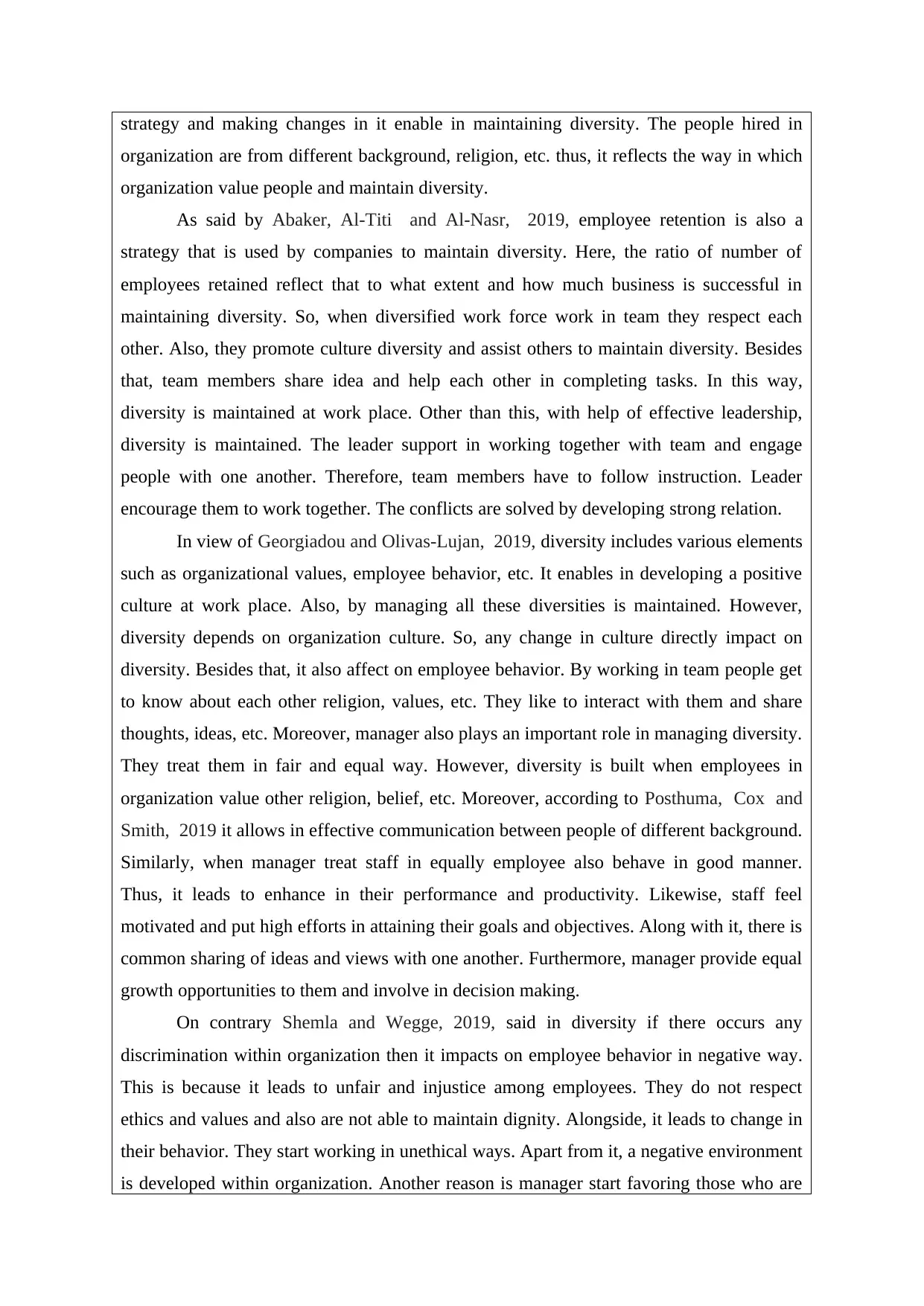
strategy and making changes in it enable in maintaining diversity. The people hired in
organization are from different background, religion, etc. thus, it reflects the way in which
organization value people and maintain diversity.
As said by Abaker, Al-Titi and Al-Nasr, 2019, employee retention is also a
strategy that is used by companies to maintain diversity. Here, the ratio of number of
employees retained reflect that to what extent and how much business is successful in
maintaining diversity. So, when diversified work force work in team they respect each
other. Also, they promote culture diversity and assist others to maintain diversity. Besides
that, team members share idea and help each other in completing tasks. In this way,
diversity is maintained at work place. Other than this, with help of effective leadership,
diversity is maintained. The leader support in working together with team and engage
people with one another. Therefore, team members have to follow instruction. Leader
encourage them to work together. The conflicts are solved by developing strong relation.
In view of Georgiadou and Olivas-Lujan, 2019, diversity includes various elements
such as organizational values, employee behavior, etc. It enables in developing a positive
culture at work place. Also, by managing all these diversities is maintained. However,
diversity depends on organization culture. So, any change in culture directly impact on
diversity. Besides that, it also affect on employee behavior. By working in team people get
to know about each other religion, values, etc. They like to interact with them and share
thoughts, ideas, etc. Moreover, manager also plays an important role in managing diversity.
They treat them in fair and equal way. However, diversity is built when employees in
organization value other religion, belief, etc. Moreover, according to Posthuma, Cox and
Smith, 2019 it allows in effective communication between people of different background.
Similarly, when manager treat staff in equally employee also behave in good manner.
Thus, it leads to enhance in their performance and productivity. Likewise, staff feel
motivated and put high efforts in attaining their goals and objectives. Along with it, there is
common sharing of ideas and views with one another. Furthermore, manager provide equal
growth opportunities to them and involve in decision making.
On contrary Shemla and Wegge, 2019, said in diversity if there occurs any
discrimination within organization then it impacts on employee behavior in negative way.
This is because it leads to unfair and injustice among employees. They do not respect
ethics and values and also are not able to maintain dignity. Alongside, it leads to change in
their behavior. They start working in unethical ways. Apart from it, a negative environment
is developed within organization. Another reason is manager start favoring those who are
organization are from different background, religion, etc. thus, it reflects the way in which
organization value people and maintain diversity.
As said by Abaker, Al-Titi and Al-Nasr, 2019, employee retention is also a
strategy that is used by companies to maintain diversity. Here, the ratio of number of
employees retained reflect that to what extent and how much business is successful in
maintaining diversity. So, when diversified work force work in team they respect each
other. Also, they promote culture diversity and assist others to maintain diversity. Besides
that, team members share idea and help each other in completing tasks. In this way,
diversity is maintained at work place. Other than this, with help of effective leadership,
diversity is maintained. The leader support in working together with team and engage
people with one another. Therefore, team members have to follow instruction. Leader
encourage them to work together. The conflicts are solved by developing strong relation.
In view of Georgiadou and Olivas-Lujan, 2019, diversity includes various elements
such as organizational values, employee behavior, etc. It enables in developing a positive
culture at work place. Also, by managing all these diversities is maintained. However,
diversity depends on organization culture. So, any change in culture directly impact on
diversity. Besides that, it also affect on employee behavior. By working in team people get
to know about each other religion, values, etc. They like to interact with them and share
thoughts, ideas, etc. Moreover, manager also plays an important role in managing diversity.
They treat them in fair and equal way. However, diversity is built when employees in
organization value other religion, belief, etc. Moreover, according to Posthuma, Cox and
Smith, 2019 it allows in effective communication between people of different background.
Similarly, when manager treat staff in equally employee also behave in good manner.
Thus, it leads to enhance in their performance and productivity. Likewise, staff feel
motivated and put high efforts in attaining their goals and objectives. Along with it, there is
common sharing of ideas and views with one another. Furthermore, manager provide equal
growth opportunities to them and involve in decision making.
On contrary Shemla and Wegge, 2019, said in diversity if there occurs any
discrimination within organization then it impacts on employee behavior in negative way.
This is because it leads to unfair and injustice among employees. They do not respect
ethics and values and also are not able to maintain dignity. Alongside, it leads to change in
their behavior. They start working in unethical ways. Apart from it, a negative environment
is developed within organization. Another reason is manager start favoring those who are
Paraphrase This Document
Need a fresh take? Get an instant paraphrase of this document with our AI Paraphraser
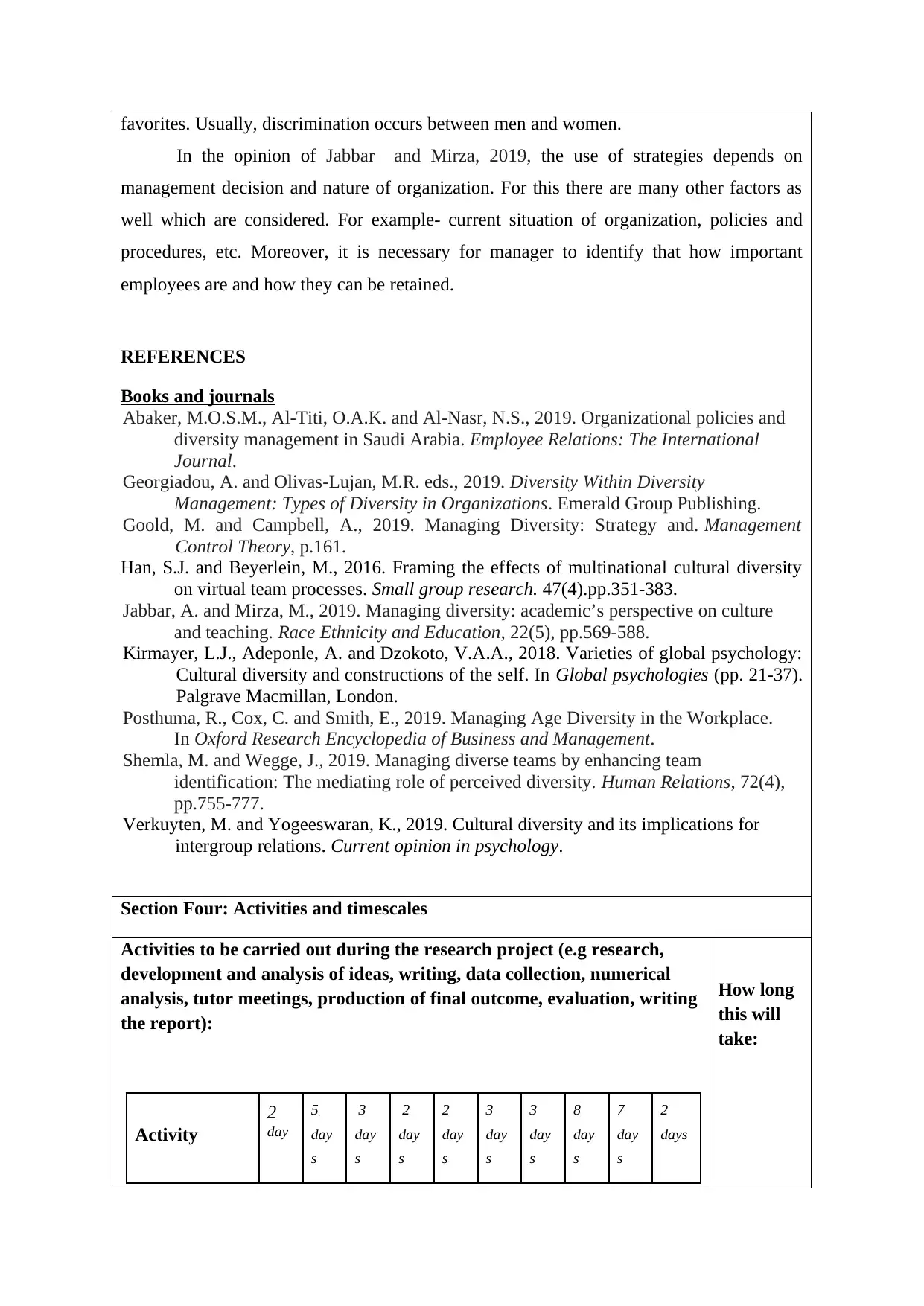
favorites. Usually, discrimination occurs between men and women.
In the opinion of Jabbar and Mirza, 2019, the use of strategies depends on
management decision and nature of organization. For this there are many other factors as
well which are considered. For example- current situation of organization, policies and
procedures, etc. Moreover, it is necessary for manager to identify that how important
employees are and how they can be retained.
REFERENCES
Books and journals
Abaker, M.O.S.M., Al-Titi, O.A.K. and Al-Nasr, N.S., 2019. Organizational policies and
diversity management in Saudi Arabia. Employee Relations: The International
Journal.
Georgiadou, A. and Olivas-Lujan, M.R. eds., 2019. Diversity Within Diversity
Management: Types of Diversity in Organizations. Emerald Group Publishing.
Goold, M. and Campbell, A., 2019. Managing Diversity: Strategy and. Management
Control Theory, p.161.
Han, S.J. and Beyerlein, M., 2016. Framing the effects of multinational cultural diversity
on virtual team processes. Small group research. 47(4).pp.351-383.
Jabbar, A. and Mirza, M., 2019. Managing diversity: academic’s perspective on culture
and teaching. Race Ethnicity and Education, 22(5), pp.569-588.
Kirmayer, L.J., Adeponle, A. and Dzokoto, V.A.A., 2018. Varieties of global psychology:
Cultural diversity and constructions of the self. In Global psychologies (pp. 21-37).
Palgrave Macmillan, London.
Posthuma, R., Cox, C. and Smith, E., 2019. Managing Age Diversity in the Workplace.
In Oxford Research Encyclopedia of Business and Management.
Shemla, M. and Wegge, J., 2019. Managing diverse teams by enhancing team
identification: The mediating role of perceived diversity. Human Relations, 72(4),
pp.755-777.
Verkuyten, M. and Yogeeswaran, K., 2019. Cultural diversity and its implications for
intergroup relations. Current opinion in psychology.
Section Four: Activities and timescales
Activities to be carried out during the research project (e.g research,
development and analysis of ideas, writing, data collection, numerical
analysis, tutor meetings, production of final outcome, evaluation, writing
the report):
Activity
2
day
5.
day
s
3
day
s
2
day
s
2
day
s
3
day
s
3
day
s
8
day
s
7
day
s
2
days
How long
this will
take:
In the opinion of Jabbar and Mirza, 2019, the use of strategies depends on
management decision and nature of organization. For this there are many other factors as
well which are considered. For example- current situation of organization, policies and
procedures, etc. Moreover, it is necessary for manager to identify that how important
employees are and how they can be retained.
REFERENCES
Books and journals
Abaker, M.O.S.M., Al-Titi, O.A.K. and Al-Nasr, N.S., 2019. Organizational policies and
diversity management in Saudi Arabia. Employee Relations: The International
Journal.
Georgiadou, A. and Olivas-Lujan, M.R. eds., 2019. Diversity Within Diversity
Management: Types of Diversity in Organizations. Emerald Group Publishing.
Goold, M. and Campbell, A., 2019. Managing Diversity: Strategy and. Management
Control Theory, p.161.
Han, S.J. and Beyerlein, M., 2016. Framing the effects of multinational cultural diversity
on virtual team processes. Small group research. 47(4).pp.351-383.
Jabbar, A. and Mirza, M., 2019. Managing diversity: academic’s perspective on culture
and teaching. Race Ethnicity and Education, 22(5), pp.569-588.
Kirmayer, L.J., Adeponle, A. and Dzokoto, V.A.A., 2018. Varieties of global psychology:
Cultural diversity and constructions of the self. In Global psychologies (pp. 21-37).
Palgrave Macmillan, London.
Posthuma, R., Cox, C. and Smith, E., 2019. Managing Age Diversity in the Workplace.
In Oxford Research Encyclopedia of Business and Management.
Shemla, M. and Wegge, J., 2019. Managing diverse teams by enhancing team
identification: The mediating role of perceived diversity. Human Relations, 72(4),
pp.755-777.
Verkuyten, M. and Yogeeswaran, K., 2019. Cultural diversity and its implications for
intergroup relations. Current opinion in psychology.
Section Four: Activities and timescales
Activities to be carried out during the research project (e.g research,
development and analysis of ideas, writing, data collection, numerical
analysis, tutor meetings, production of final outcome, evaluation, writing
the report):
Activity
2
day
5.
day
s
3
day
s
2
day
s
2
day
s
3
day
s
3
day
s
8
day
s
7
day
s
2
days
How long
this will
take:
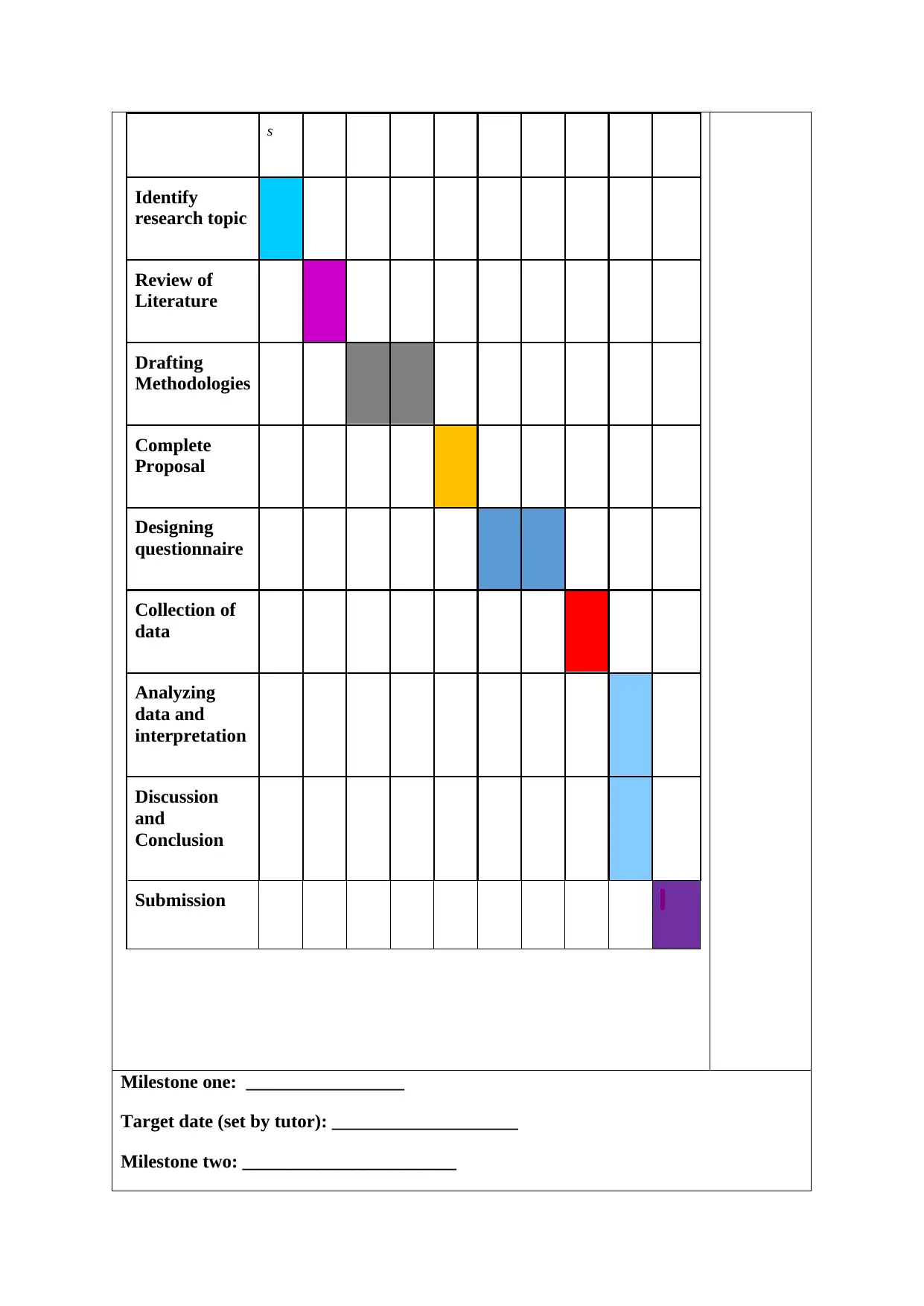
s
Identify
research topic
Review of
Literature
Drafting
Methodologies
Complete
Proposal
Designing
questionnaire
Collection of
data
Analyzing
data and
interpretation
Discussion
and
Conclusion
Submission
Milestone one: _________________
Target date (set by tutor): ____________________
Milestone two: _______________________
Identify
research topic
Review of
Literature
Drafting
Methodologies
Complete
Proposal
Designing
questionnaire
Collection of
data
Analyzing
data and
interpretation
Discussion
and
Conclusion
Submission
Milestone one: _________________
Target date (set by tutor): ____________________
Milestone two: _______________________
⊘ This is a preview!⊘
Do you want full access?
Subscribe today to unlock all pages.

Trusted by 1+ million students worldwide
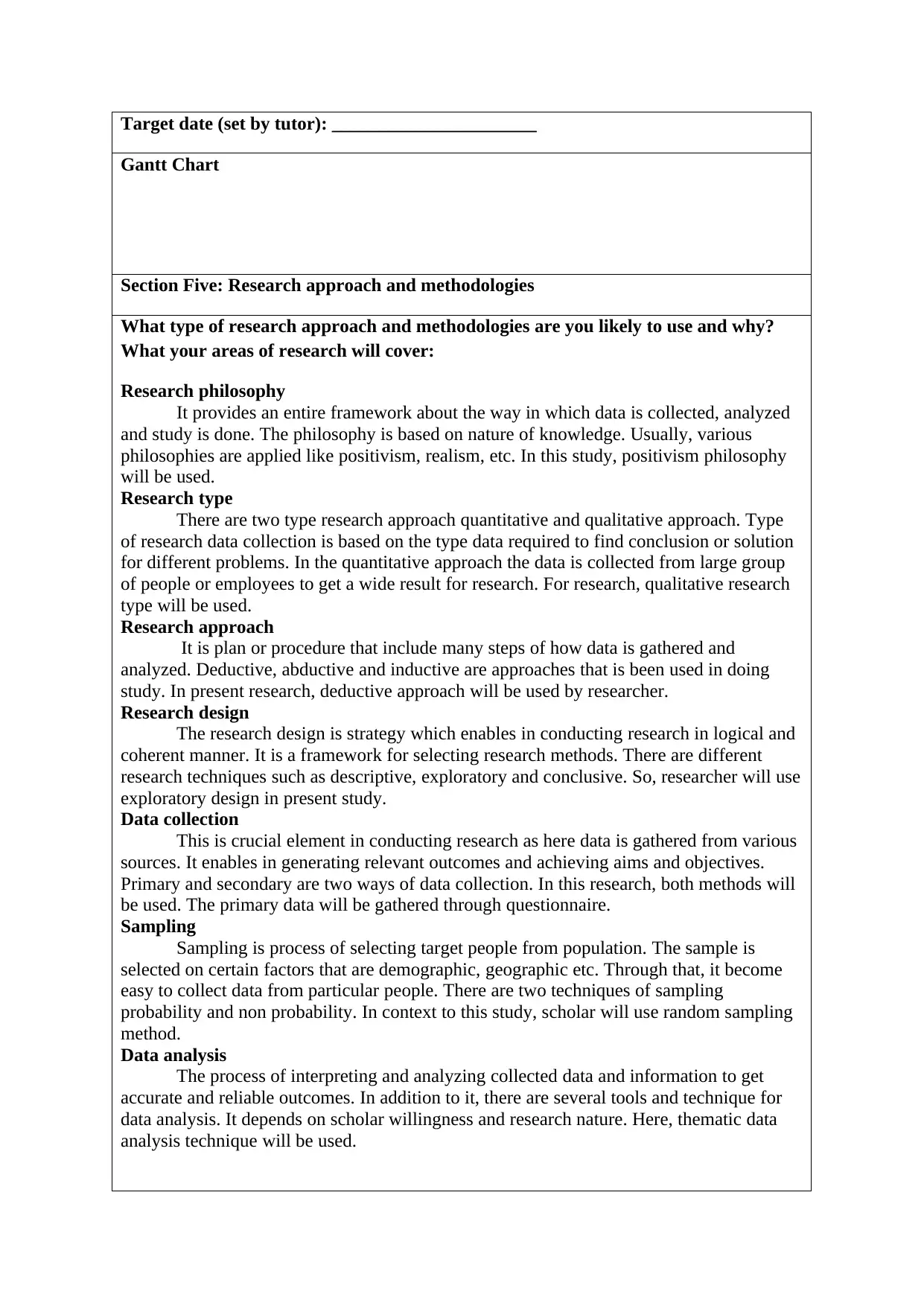
Target date (set by tutor): ______________________
Gantt Chart
Section Five: Research approach and methodologies
What type of research approach and methodologies are you likely to use and why?
What your areas of research will cover:
Research philosophy
It provides an entire framework about the way in which data is collected, analyzed
and study is done. The philosophy is based on nature of knowledge. Usually, various
philosophies are applied like positivism, realism, etc. In this study, positivism philosophy
will be used.
Research type
There are two type research approach quantitative and qualitative approach. Type
of research data collection is based on the type data required to find conclusion or solution
for different problems. In the quantitative approach the data is collected from large group
of people or employees to get a wide result for research. For research, qualitative research
type will be used.
Research approach
It is plan or procedure that include many steps of how data is gathered and
analyzed. Deductive, abductive and inductive are approaches that is been used in doing
study. In present research, deductive approach will be used by researcher.
Research design
The research design is strategy which enables in conducting research in logical and
coherent manner. It is a framework for selecting research methods. There are different
research techniques such as descriptive, exploratory and conclusive. So, researcher will use
exploratory design in present study.
Data collection
This is crucial element in conducting research as here data is gathered from various
sources. It enables in generating relevant outcomes and achieving aims and objectives.
Primary and secondary are two ways of data collection. In this research, both methods will
be used. The primary data will be gathered through questionnaire.
Sampling
Sampling is process of selecting target people from population. The sample is
selected on certain factors that are demographic, geographic etc. Through that, it become
easy to collect data from particular people. There are two techniques of sampling
probability and non probability. In context to this study, scholar will use random sampling
method.
Data analysis
The process of interpreting and analyzing collected data and information to get
accurate and reliable outcomes. In addition to it, there are several tools and technique for
data analysis. It depends on scholar willingness and research nature. Here, thematic data
analysis technique will be used.
Gantt Chart
Section Five: Research approach and methodologies
What type of research approach and methodologies are you likely to use and why?
What your areas of research will cover:
Research philosophy
It provides an entire framework about the way in which data is collected, analyzed
and study is done. The philosophy is based on nature of knowledge. Usually, various
philosophies are applied like positivism, realism, etc. In this study, positivism philosophy
will be used.
Research type
There are two type research approach quantitative and qualitative approach. Type
of research data collection is based on the type data required to find conclusion or solution
for different problems. In the quantitative approach the data is collected from large group
of people or employees to get a wide result for research. For research, qualitative research
type will be used.
Research approach
It is plan or procedure that include many steps of how data is gathered and
analyzed. Deductive, abductive and inductive are approaches that is been used in doing
study. In present research, deductive approach will be used by researcher.
Research design
The research design is strategy which enables in conducting research in logical and
coherent manner. It is a framework for selecting research methods. There are different
research techniques such as descriptive, exploratory and conclusive. So, researcher will use
exploratory design in present study.
Data collection
This is crucial element in conducting research as here data is gathered from various
sources. It enables in generating relevant outcomes and achieving aims and objectives.
Primary and secondary are two ways of data collection. In this research, both methods will
be used. The primary data will be gathered through questionnaire.
Sampling
Sampling is process of selecting target people from population. The sample is
selected on certain factors that are demographic, geographic etc. Through that, it become
easy to collect data from particular people. There are two techniques of sampling
probability and non probability. In context to this study, scholar will use random sampling
method.
Data analysis
The process of interpreting and analyzing collected data and information to get
accurate and reliable outcomes. In addition to it, there are several tools and technique for
data analysis. It depends on scholar willingness and research nature. Here, thematic data
analysis technique will be used.
Paraphrase This Document
Need a fresh take? Get an instant paraphrase of this document with our AI Paraphraser
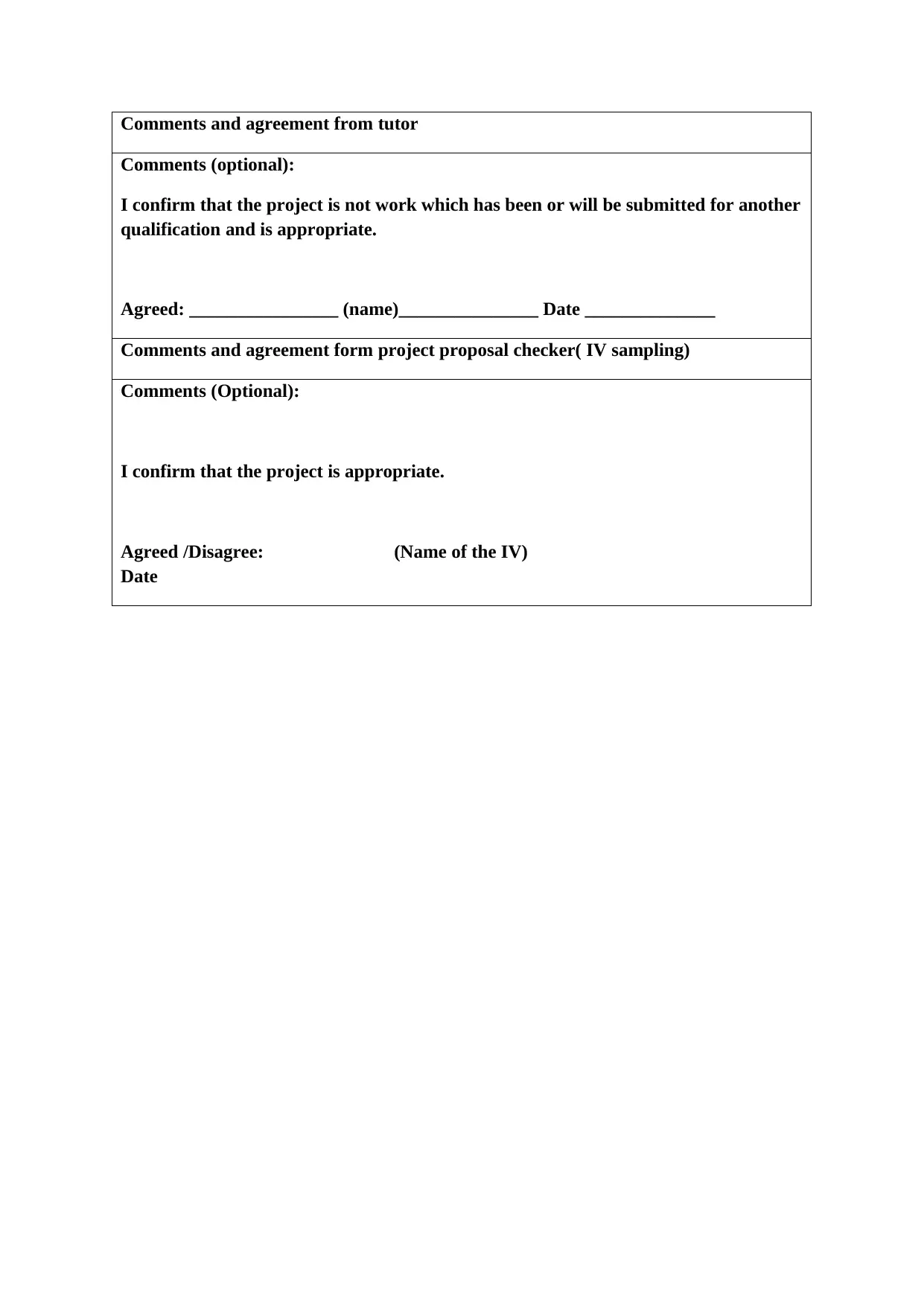
Comments and agreement from tutor
Comments (optional):
I confirm that the project is not work which has been or will be submitted for another
qualification and is appropriate.
Agreed: ________________ (name)_______________ Date ______________
Comments and agreement form project proposal checker( IV sampling)
Comments (Optional):
I confirm that the project is appropriate.
Agreed /Disagree: (Name of the IV)
Date
Comments (optional):
I confirm that the project is not work which has been or will be submitted for another
qualification and is appropriate.
Agreed: ________________ (name)_______________ Date ______________
Comments and agreement form project proposal checker( IV sampling)
Comments (Optional):
I confirm that the project is appropriate.
Agreed /Disagree: (Name of the IV)
Date
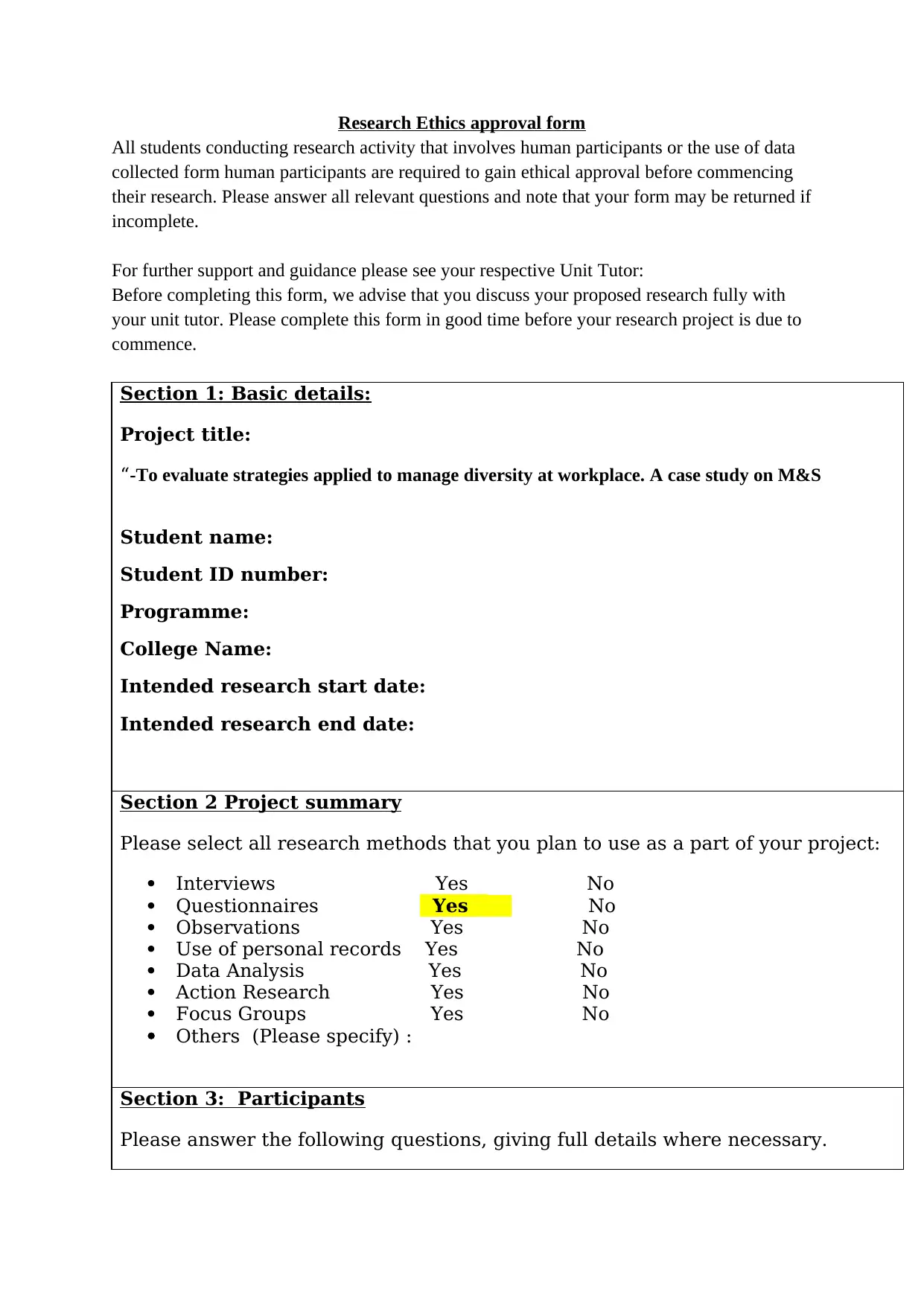
Research Ethics approval form
All students conducting research activity that involves human participants or the use of data
collected form human participants are required to gain ethical approval before commencing
their research. Please answer all relevant questions and note that your form may be returned if
incomplete.
For further support and guidance please see your respective Unit Tutor:
Before completing this form, we advise that you discuss your proposed research fully with
your unit tutor. Please complete this form in good time before your research project is due to
commence.
Section 1: Basic details:
Project title:
“-To evaluate strategies applied to manage diversity at workplace. A case study on M&S
Student name:
Student ID number:
Programme:
College Name:
Intended research start date:
Intended research end date:
Section 2 Project summary
Please select all research methods that you plan to use as a part of your project:
Interviews Yes No
Questionnaires Yes No
Observations Yes No
Use of personal records Yes No
Data Analysis Yes No
Action Research Yes No
Focus Groups Yes No
Others (Please specify) :
Section 3: Participants
Please answer the following questions, giving full details where necessary.
All students conducting research activity that involves human participants or the use of data
collected form human participants are required to gain ethical approval before commencing
their research. Please answer all relevant questions and note that your form may be returned if
incomplete.
For further support and guidance please see your respective Unit Tutor:
Before completing this form, we advise that you discuss your proposed research fully with
your unit tutor. Please complete this form in good time before your research project is due to
commence.
Section 1: Basic details:
Project title:
“-To evaluate strategies applied to manage diversity at workplace. A case study on M&S
Student name:
Student ID number:
Programme:
College Name:
Intended research start date:
Intended research end date:
Section 2 Project summary
Please select all research methods that you plan to use as a part of your project:
Interviews Yes No
Questionnaires Yes No
Observations Yes No
Use of personal records Yes No
Data Analysis Yes No
Action Research Yes No
Focus Groups Yes No
Others (Please specify) :
Section 3: Participants
Please answer the following questions, giving full details where necessary.
⊘ This is a preview!⊘
Do you want full access?
Subscribe today to unlock all pages.

Trusted by 1+ million students worldwide
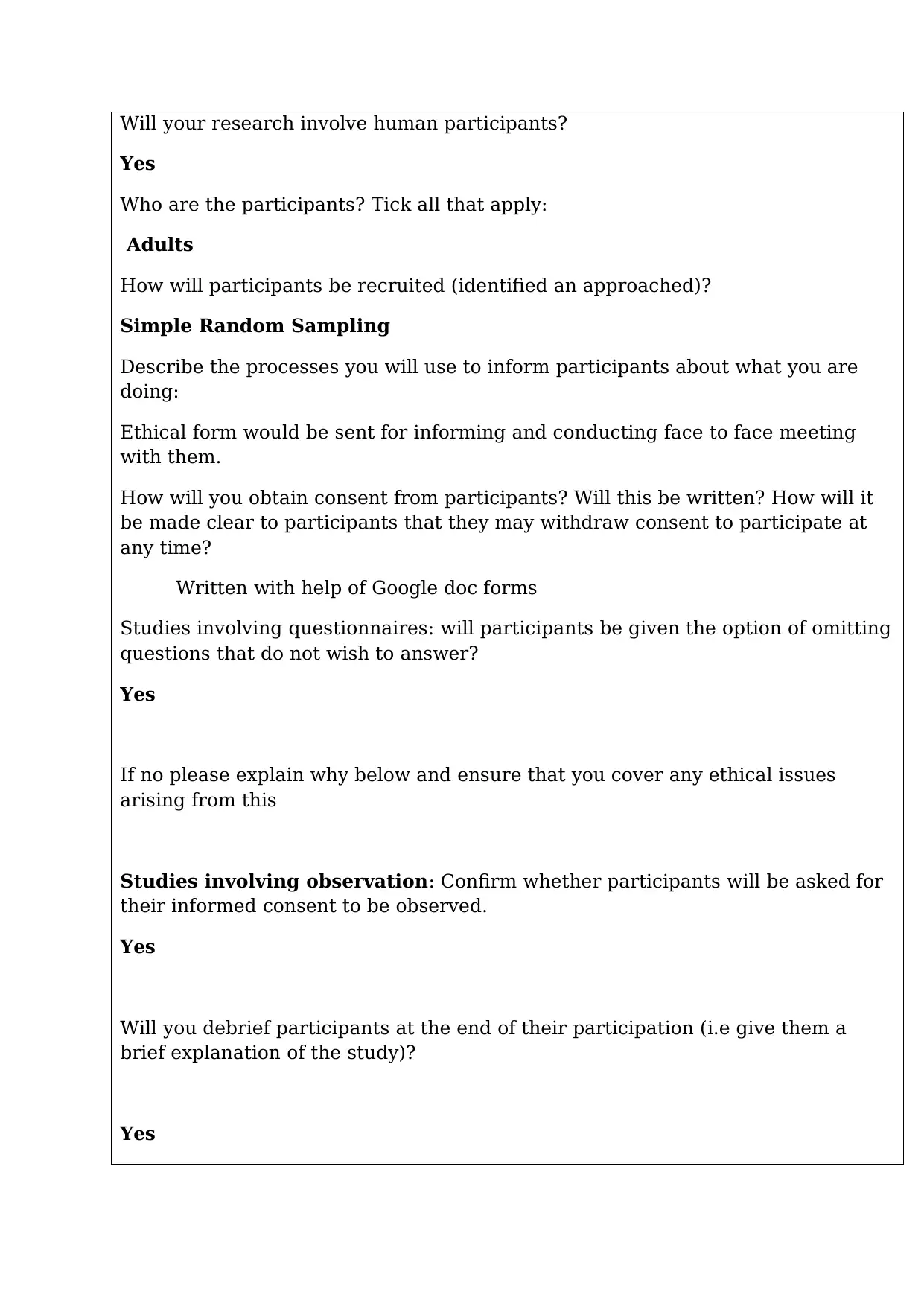
Will your research involve human participants?
Yes
Who are the participants? Tick all that apply:
Adults
How will participants be recruited (identified an approached)?
Simple Random Sampling
Describe the processes you will use to inform participants about what you are
doing:
Ethical form would be sent for informing and conducting face to face meeting
with them.
How will you obtain consent from participants? Will this be written? How will it
be made clear to participants that they may withdraw consent to participate at
any time?
Written with help of Google doc forms
Studies involving questionnaires: will participants be given the option of omitting
questions that do not wish to answer?
Yes
If no please explain why below and ensure that you cover any ethical issues
arising from this
Studies involving observation: Confirm whether participants will be asked for
their informed consent to be observed.
Yes
Will you debrief participants at the end of their participation (i.e give them a
brief explanation of the study)?
Yes
Yes
Who are the participants? Tick all that apply:
Adults
How will participants be recruited (identified an approached)?
Simple Random Sampling
Describe the processes you will use to inform participants about what you are
doing:
Ethical form would be sent for informing and conducting face to face meeting
with them.
How will you obtain consent from participants? Will this be written? How will it
be made clear to participants that they may withdraw consent to participate at
any time?
Written with help of Google doc forms
Studies involving questionnaires: will participants be given the option of omitting
questions that do not wish to answer?
Yes
If no please explain why below and ensure that you cover any ethical issues
arising from this
Studies involving observation: Confirm whether participants will be asked for
their informed consent to be observed.
Yes
Will you debrief participants at the end of their participation (i.e give them a
brief explanation of the study)?
Yes
Paraphrase This Document
Need a fresh take? Get an instant paraphrase of this document with our AI Paraphraser
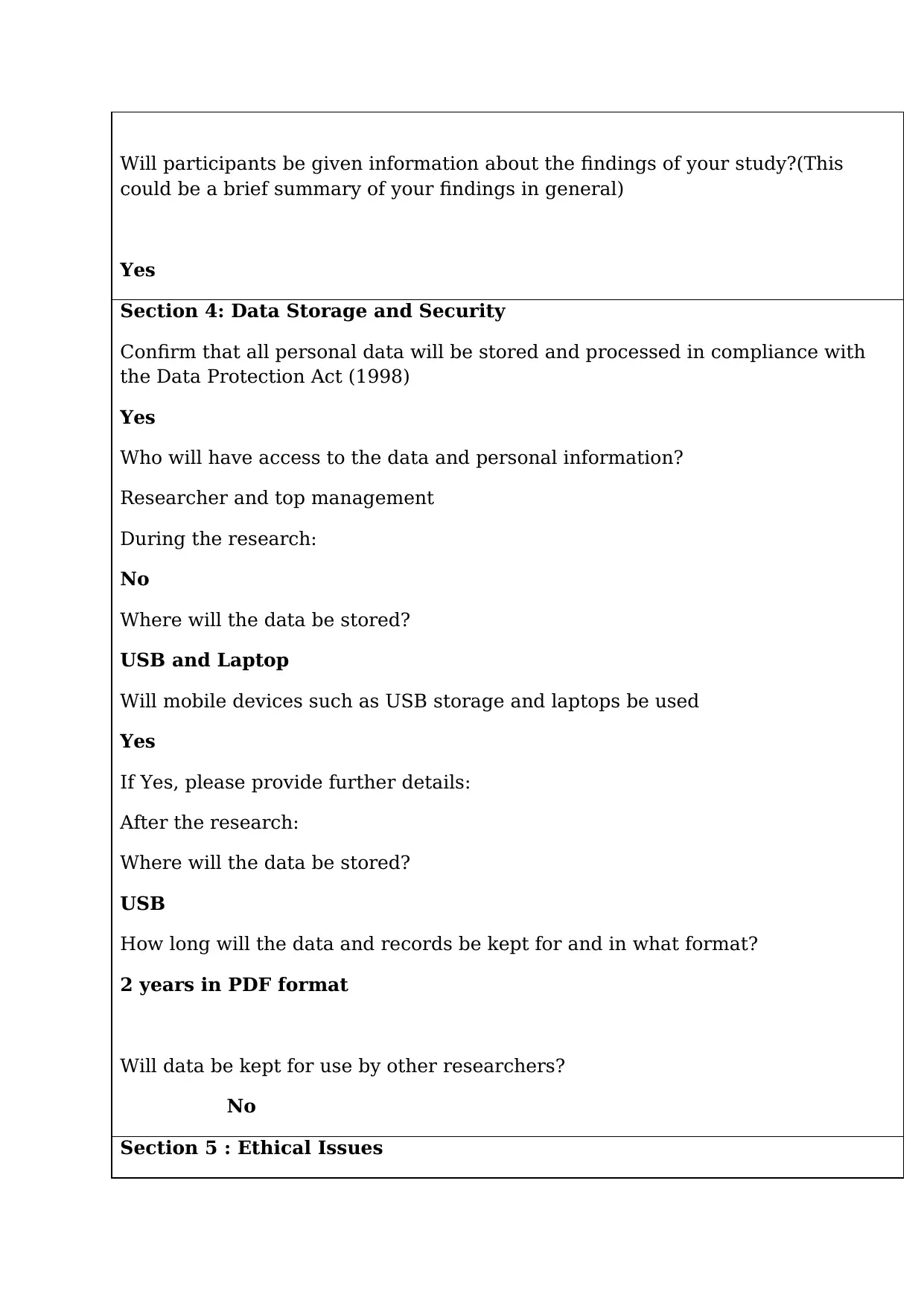
Will participants be given information about the findings of your study?(This
could be a brief summary of your findings in general)
Yes
Section 4: Data Storage and Security
Confirm that all personal data will be stored and processed in compliance with
the Data Protection Act (1998)
Yes
Who will have access to the data and personal information?
Researcher and top management
During the research:
No
Where will the data be stored?
USB and Laptop
Will mobile devices such as USB storage and laptops be used
Yes
If Yes, please provide further details:
After the research:
Where will the data be stored?
USB
How long will the data and records be kept for and in what format?
2 years in PDF format
Will data be kept for use by other researchers?
No
Section 5 : Ethical Issues
could be a brief summary of your findings in general)
Yes
Section 4: Data Storage and Security
Confirm that all personal data will be stored and processed in compliance with
the Data Protection Act (1998)
Yes
Who will have access to the data and personal information?
Researcher and top management
During the research:
No
Where will the data be stored?
USB and Laptop
Will mobile devices such as USB storage and laptops be used
Yes
If Yes, please provide further details:
After the research:
Where will the data be stored?
USB
How long will the data and records be kept for and in what format?
2 years in PDF format
Will data be kept for use by other researchers?
No
Section 5 : Ethical Issues
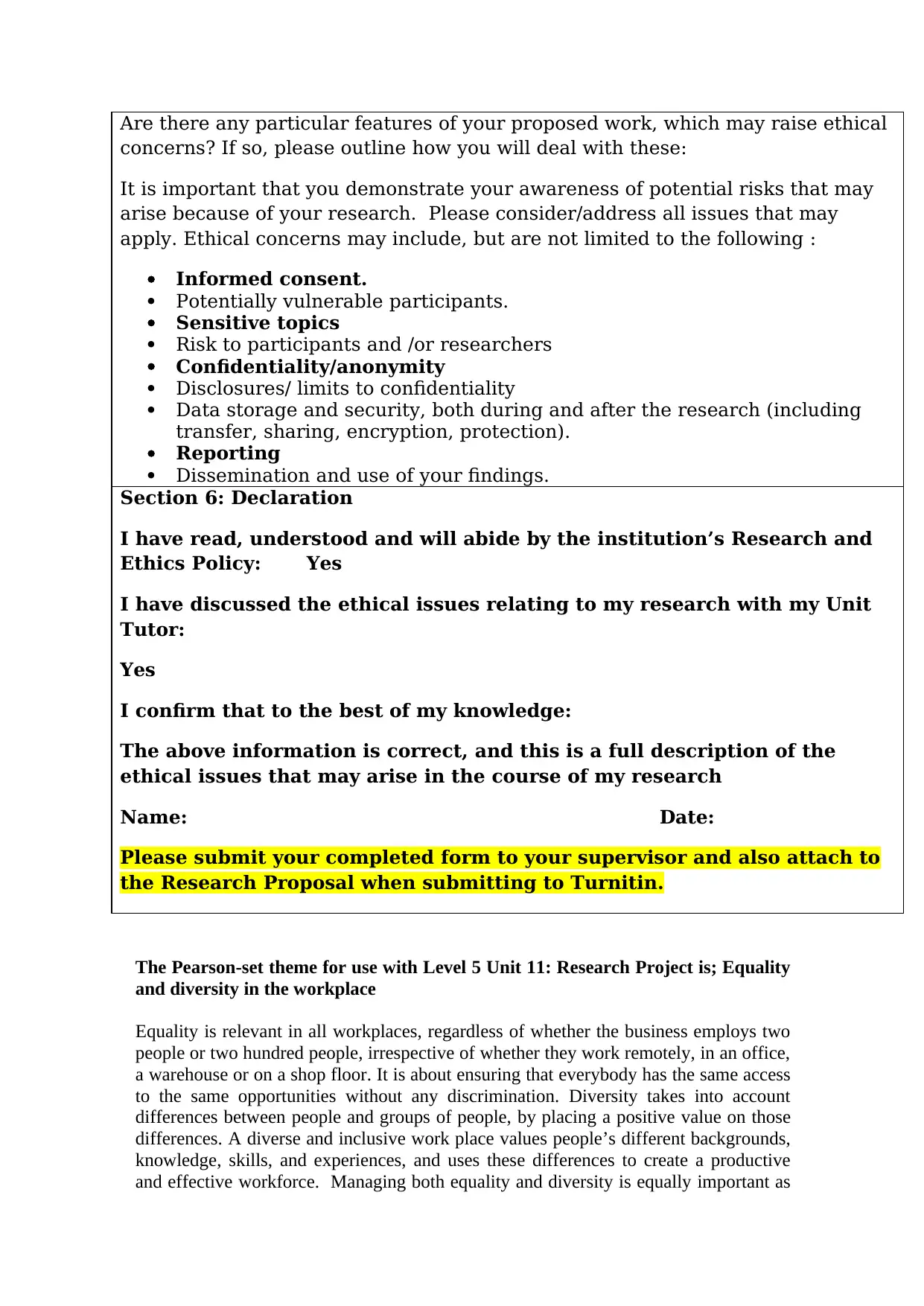
Are there any particular features of your proposed work, which may raise ethical
concerns? If so, please outline how you will deal with these:
It is important that you demonstrate your awareness of potential risks that may
arise because of your research. Please consider/address all issues that may
apply. Ethical concerns may include, but are not limited to the following :
Informed consent.
Potentially vulnerable participants.
Sensitive topics
Risk to participants and /or researchers
Confidentiality/anonymity
Disclosures/ limits to confidentiality
Data storage and security, both during and after the research (including
transfer, sharing, encryption, protection).
Reporting
Dissemination and use of your findings.
Section 6: Declaration
I have read, understood and will abide by the institution’s Research and
Ethics Policy: Yes
I have discussed the ethical issues relating to my research with my Unit
Tutor:
Yes
I confirm that to the best of my knowledge:
The above information is correct, and this is a full description of the
ethical issues that may arise in the course of my research
Name: Date:
Please submit your completed form to your supervisor and also attach to
the Research Proposal when submitting to Turnitin.
The Pearson-set theme for use with Level 5 Unit 11: Research Project is; Equality
and diversity in the workplace
Equality is relevant in all workplaces, regardless of whether the business employs two
people or two hundred people, irrespective of whether they work remotely, in an office,
a warehouse or on a shop floor. It is about ensuring that everybody has the same access
to the same opportunities without any discrimination. Diversity takes into account
differences between people and groups of people, by placing a positive value on those
differences. A diverse and inclusive work place values people’s different backgrounds,
knowledge, skills, and experiences, and uses these differences to create a productive
and effective workforce. Managing both equality and diversity is equally important as
concerns? If so, please outline how you will deal with these:
It is important that you demonstrate your awareness of potential risks that may
arise because of your research. Please consider/address all issues that may
apply. Ethical concerns may include, but are not limited to the following :
Informed consent.
Potentially vulnerable participants.
Sensitive topics
Risk to participants and /or researchers
Confidentiality/anonymity
Disclosures/ limits to confidentiality
Data storage and security, both during and after the research (including
transfer, sharing, encryption, protection).
Reporting
Dissemination and use of your findings.
Section 6: Declaration
I have read, understood and will abide by the institution’s Research and
Ethics Policy: Yes
I have discussed the ethical issues relating to my research with my Unit
Tutor:
Yes
I confirm that to the best of my knowledge:
The above information is correct, and this is a full description of the
ethical issues that may arise in the course of my research
Name: Date:
Please submit your completed form to your supervisor and also attach to
the Research Proposal when submitting to Turnitin.
The Pearson-set theme for use with Level 5 Unit 11: Research Project is; Equality
and diversity in the workplace
Equality is relevant in all workplaces, regardless of whether the business employs two
people or two hundred people, irrespective of whether they work remotely, in an office,
a warehouse or on a shop floor. It is about ensuring that everybody has the same access
to the same opportunities without any discrimination. Diversity takes into account
differences between people and groups of people, by placing a positive value on those
differences. A diverse and inclusive work place values people’s different backgrounds,
knowledge, skills, and experiences, and uses these differences to create a productive
and effective workforce. Managing both equality and diversity is equally important as
⊘ This is a preview!⊘
Do you want full access?
Subscribe today to unlock all pages.

Trusted by 1+ million students worldwide
1 out of 14
Related Documents
Your All-in-One AI-Powered Toolkit for Academic Success.
+13062052269
info@desklib.com
Available 24*7 on WhatsApp / Email
![[object Object]](/_next/static/media/star-bottom.7253800d.svg)
Unlock your academic potential
Copyright © 2020–2025 A2Z Services. All Rights Reserved. Developed and managed by ZUCOL.




